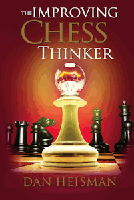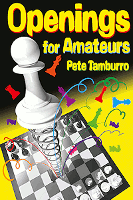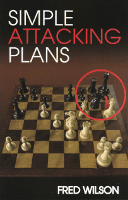The Psychology of Systematic Chess Thinking
Review by Stephen Munroe
The Improving Chess Thinker, Second Edition, by Dan Heisman, Mongoose Press, Figurine Algebraic Notation, Paperback, $21.95 (ChessCafe Price $18.37)
In the competitive arena, the phrase “chess psychology” sometimes refers to strategies used to distract, unsettle or anticipate one’s opponent, that is, strategies for playing the person as opposed to strictly playing the position on the board. This use of psychology in chess could not be further from that presented in the second edition of The Improving Chess Thinker by Dan Heisman, a well-known chess writer, experienced instructor and long-time ChessCafe.com columnist. In this book Heisman doubles down on the lessons espoused in his previous writing, focusing almost exclusively on how players think about chess and how players can improve their efficiency and focus over the board.
In the introduction to this volume Heisman states that “few beginners are taught how to think” in searching for their best move. He argues that cultivating systematic habits of thought is essential for improving one’s chess, especially when one seeks to progress from beginner and mid-range class player to higher levels of play, i.e., those of experts and masters. Here Heisman lays out in an engaging and understandable way the underpinnings of his approach to instruction, introducing terminology such as “hope chess,” “hand waving” and “real chess” that may be familiar to readers of his columns and books.
The Improving Chess Thinker is divided into two distinct parts. The first part, Chapters 1-8, presents the results of a long-term investigation into ways in which different levels of players analyze positions. These studies of the thought processes of chess players reveal aspects of the cognitive psychology of chess, as the reader is led through a series of written transcriptions of what players verbalize of their thinking as they study a position and select their best move. These transcriptions are termed “protocols.” The comments, musings, and analysis of each player are rendered by Heisman as accurately as possible as they select their best move when presented with a particular mid-game position.
Chapter 1 (“The Exercise”) introduces the general methods of this study and presents six positions that are used repeatedly in subsequent chapters. It includes several pages subtitled “Instructions for the de Groot Exercises” and two more subtitled “Post-Exercise Review.” These lay out the conditions and goals of the studies presented in the first half of this book. Chapters 2-8 each give about a dozen protocols from players of increasing strength. The chapters progress class by class, starting with Class F players in Chapter 2 to Class A in Chapter 7 and “Expert and Beyond” in Chapter 8. These protocols comprise a collection of varied and representative examples that Heisman has accumulated over decades. As the same position is presented over and over to different subjects, the analysis within the protocols has a certain repetitive quality but none are exactly the same. All in all, they make for interesting reading, at least for those who are intrigued by this systematic effort to record and probe the thought processes that lie behind each move on the chess board.
For each protocol, the rating of the subject and the time taken to select a move is noted. Some protocols are very short, reflecting only a couple minutes of study; others take more than half an hour and extend over several pages of text. For each protocol Heisman also offers comments and evaluates the quality of the thought process of the players as much as their choice of move. Unsurprisingly, lower level players often overlook features of the position that are obvious to better players. However, the focus is never on the blunders and oversights themselves; rather, Heisman endeavors to point out the various ways different players organize their analysis (or not) and work through the merits of assorted moves before finally selecting just one. In this respect, some of the lowest-rated players distinguish themselves, while some much more highly rated players show weaknesses more typical of the lower ranks. When prompted, players give their principal variation or PV, the line of analysis that best explains the move selected. Only gradually does Heisman reveal a definitive analysis for most positions, and this comes in the context of the many other lines (plausible or not) that different players have found.
The use of such verbalized protocols in exploring thinking in chess has a long history, originating with the work of Adriaan de Groot (1914-2006), a Dutch psychologist and master-level chess player. Among a number of individuals of the past century who were both professional psychologists and talented chess players (Reuben Fine and Eliot Hearst being two notable examples), de Groot’s contributions to chess psychology stand out, and they continue to resonate in modern efforts to apply artificial intelligence approaches to computerized chess. As a graduate student in the 1930s, Dr. de Groot developed the approach described above that Heisman explores and essentially replicates in the first half of The Improving Chess Thinker. De Groot’s work commanded attention in part because he was able to recruit to his doctoral research some of the best players of his time – Alekhine, Keres, Euwe, and Fine among others. Heisman, in contrast, focuses on the thought processes of the developing class player.
In introducing the reader to de Groot’s methods, Heisman describes his own fascination when he first read de Groot’s classic but highly technical work, Thought and Choice in Chess (all 463 pages!), as a teenager in the late 1960s. Soon the young Heisman began his attempts to replicate de Groot’s studies, asking friends and fellow chess players to verbalize their thinking as they analyzed the same positions that de Groot had used decades before. Heisman’s psychological investigations have continued to the present day, leading to an accumulation of hundreds of protocols. Most importantly, the results of Heisman’s extension of de Groot’s methods to study a large number of lower-ranked players (often his students) have informed Heisman’s instructional philosophy and methods, making him a strong advocate of honing one’s chess skills by disciplined improvement of one’s own thinking processes.
In the second half of the book, Heisman distills practical lessons from the results of these studies. Subsequent chapters include a very readable narrative account of “Thought Process Basics” (Chapter 9), “The Most Common Thought Process Mistakes” (Chapter 11) and ways to incorporate this thinking into practical tournament play (“The Basics of Time Management,” Chapter 12). Heisman presents additional exercises and suggestions for how players below master strength can use the approach pioneered by de Groot to improve their own thinking skills. In Appendix A he presents de Groot’s account of Dr. Max Euwe’s analysis of “de Groot position A,” shown below, a total of two pages of this grandmaster’s verbalization. Heisman’s point in laying out the spontaneous analysis of this former world champion (World Champion from 1935-37) is not to awe, but to show that a grandmaster’s systematic thought processes are not so difficult to emulate.
Indeed, de Groot’s studies revealed that what distinguishes world-class players from amateurs is not the depth of their calculations, but their ability to recognize and distinguish between many thousands of subtly different positions. While practice is critical for developing this skill, Heisman argues that beginning and average players also need to work hard to develop systematic approaches to analysis that will help optimize their efforts to select the best move. In developing such a disciplined approach, the less skilled player will gradually abandon sloppy habits of “hope chess” and “hand-waving.” The final chapter of the book (Chapter 14) presents additional exercises and some amusing anecdotes based on Heisman’s years of experience teaching chess.
The figures below reproduce two of the six de Groot positions that Heisman uses throughout the book. The first, “de Groot A,” is the one most frequently used. As with most of the other de Groot positions, it represents a fairly balanced, well-developed position, but one without obvious mating combinations. The second position, “de Groot Zyme,” is less balanced, with both kings exposed to possible attack. To say more about these positions would be to give away too much, as the book revolves around the analysis of these and the four other positions presented in Chapter 1. Heisman encourages the reader to set aside some time and decide upon a move as if you were playing the game with a time control of forty moves in two hours. I second this recommendation.
de Groot A (white to play)
![[FEN “2r2rk1/pp2bp1p/1qb1pnp1/3nN1B1/3P4/P1NQ4/BP3PPP/R4RK1”]](https://chesscafe.com/wp-content/uploads/2014/10/review959a.gif)
[FEN “2r2rk1/pp2bp1p/1qb1pnp1/3nN1B1/3P4/P1NQ4/BP3PPP/R4RK1”]
de Groot Zyme (white to play)
![[FEN “r1bk3r/p4p2/3B1q1p/1p4p1/2p1Q1n1/2P5/4PPPP/R3KB1R”]](https://chesscafe.com/wp-content/uploads/2014/10/review959b.gif)
[FEN “r1bk3r/p4p2/3B1q1p/1p4p1/2p1Q1n1/2P5/4PPPP/R3KB1R”]
The reader who finds this exercise instructive and intriguing will readily appreciate the instruction and advice offered in the second half of this book. Much is common sense (i.e., first make an overall evaluation of the position, look for captures, checks, and threats), and the emphasis is always on how to think through a position. There is also advice on avoiding common pitfalls, such as assuming the opponent will make a particular unforced move and spending time analyzing unprofitable lines of play in comparison with time spent on analyzing the move you actually decide to play. These types of errors Heisman attributes to playing “hope chess” (making a move without checking consistently to see if your opponent has a forcing move you cannot safely answer) or “hand-waving” (choosing a move just on principle, omitting specific move-by-move analysis). These and other thought process mistakes are illustrated with many strikingly straightforward and typical examples of student play. Hand-waving is demonstrated with the position below in which the hand-waving student, ahead in material, with ample time on his clock and with only two legal moves to choose between, played Rxg7?? rather than Kxg7 to avoid exposing his king. Unfortunately, 1…Rxg7 loses in two moves to 2.Qxc8+. The rejected move, 1…Kxg7, wins easily in all variations, as demonstrated by a short but systematic analysis of White’s replies. Problems associated with playing too fast or too slow are thoroughly discussed in several chapters in different contexts, with specific and practical advice for tournament play summed up in Chapter 12. Throughout the book, the author enlivens the text with anecdotes taken from his experiences as a professional instructor and amateur chess psychologist, concluding the book with Chapter 14: “Additional Exercises and Lesson Tales.”
Black to play after 1.fxg7+
![[FEN “2r3rk/1p3pPp/p1n5/6B1/1q4Q1/3n3P/2P3PK/8”]](https://chesscafe.com/wp-content/uploads/2014/10/review959c.gif)
[FEN “2r3rk/1p3pPp/p1n5/6B1/1q4Q1/3n3P/2P3PK/8”]
There is much more here of use to the great majority of players of the game. Heisman’s analysis of the six de Groot positions, to which he returns throughout this book, is ultimately both instructive and thorough, incorporating computer analysis in Appendix B that in some cases refutes the analysis offered by de Groot himself. I found instructive distinctions made in Chapter 11 between tactical vision (the ability to recognize tactical patterns, on defense as well as offense) and board vision (the ability to recognize quickly and accurately “where all the pieces are and to assess what they are doing in the current position”). These distinctions are well illustrated with two very simple forced-mate examples taken from lessons with his students. Near the end of the book, Heisman provides guidelines for adapting de Groot’s approach to training oneself (or one’s students) with other positions. The classic de Groot positions, it turns out, were drawn from de Groot’s own games.
For those unfamiliar with the first edition, this second edition of the Improving Chess Thinker will provide a very different perspective on chess playing than that offered by other books. In this revised and expanded edition new protocols have been added and older ones edited for clarity. This book will be most interesting and useful for players below the expert level who have a few years of practical experience and some exposure to chess theory. One group of players for whom this book will prove especially valuable (some may regard it as essential!) includes those who teach or coach chess at the high school or elementary school level. Dan Heisman is an accomplished instructor and a careful student of the game. This book represents a concise summary of the lessons he has learned himself and those he has taught his students over many years.
My assessment of this book:
![]()
Order The Improving Chess Thinker
by Dan Heisman
© 2014 ChessEdu.org. All Rights Reserved.




Leave a Reply